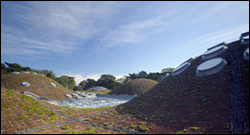
by Shane Henson — October 7, 2011—Building and facilities managers needing inspiration as they plan to make their buildings more sustainable and seek LEED accreditation could learn much from the California Academy of Sciences. Just three years ago, the academy unveiled the world’s greenest museum—an eco-friendly new home featuring a hilly living roof, recycled denim insulation, and many other green innovations. Now, more than five million visitors later, the museum celebrates another symbolic color: platinum. The U.S. Green Building Council recently presented the academy with its second LEED Platinum award, reportedly making the California Academy of Sciences the world’s first double-platinum museum and the world’s largest double-platinum building.
Founded in 1853, the California Academy of Sciences is one of the world’s preeminent natural history museums and is an international leader in scientific research about the natural world. The 1989 Loma Prieta earthquake damaged the academy’s original home in Golden Gate Park, but also provided a silver lining: the opportunity to reinvent the facility from the ground up. After nearly a decade of planning and the largest cultural fundraising effort in San Francisco history, the new academy opened to the public in 2008. Designed by Italian architect Renzo Piano, the academy building houses an aquarium, planetarium, natural history museum, and world-class research and education programs under one living roof.
A wide range of business practices and performance metrics earned the academy LEED points for existing buildings: operations and maintenance. They include:
Choice of Materials
- 100% of the academy’s computers are Energy Star rated;
- 100% of the academy’s printer paper is composed entirely of post-consumer recycled content;
- Nearly all of the academy’s cleaning products are green-seal certified, and all custodial paper products have recycled content;
- Materials used for facility renovations and alterations contain low or no amounts of volatile organic compounds;
- The academy uses low-emission and ozone-friendly substances for refrigeration, heating, ventilation, air conditioning, and fire suppression.
- 100% of the academy’s printer paper is composed entirely of post-consumer recycled content;
Recycling and Waste Disposal
- 60-65% of the academy’s waste is diverted from the landfill into recycling or compost;
- Electronic waste is handled by GreenCitizen, a Bay Area company that helps individuals and businesses repair, reuse, and recycle electronics.

Water and Energy
- The academy’s data center reduced the number of its physical servers by 41% while simultaneously increasing the use of virtual machines. This restructuring results in energy savings of 166,000 kWh per year despite a 52% increase in computing capacity;
- Water use is 32% below the LEED baseline thanks to waterless urinals and low-flow faucets, toilets, and shower heads;
- Nearly 100% of the academy’s electricity comes from clean energy sources.
- Water use is 32% below the LEED baseline thanks to waterless urinals and low-flow faucets, toilets, and shower heads;
Indoor Environment
- Outdoor views are available in 98% of regularly occupied spaces;
- Staff can control lighting in 93% of the workspaces;
- The academy has installed CO2 sensors, airflow monitoring, and demand-based ventilation systems.





